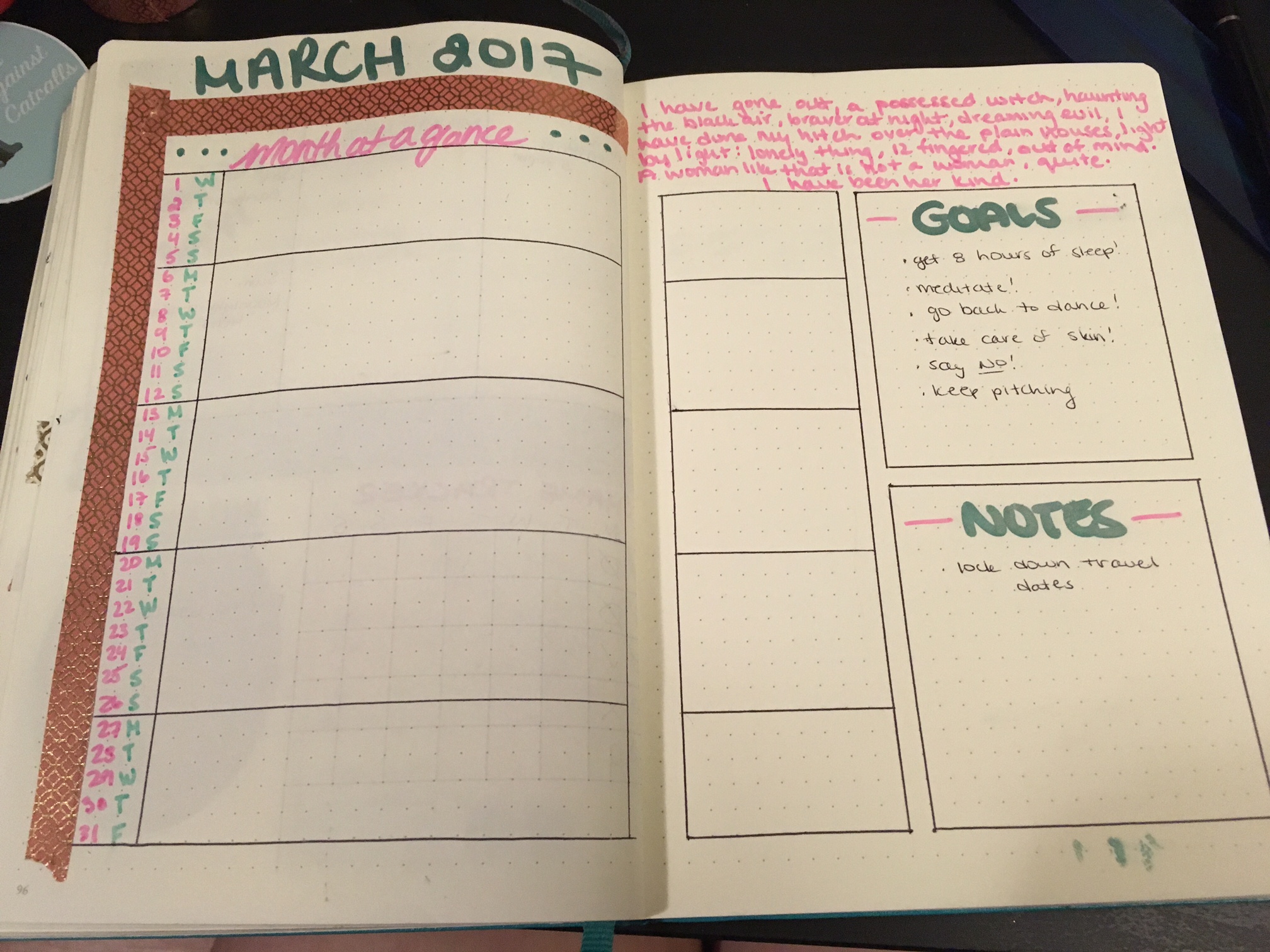So it’s probably no big secret that I do A Lot of Things. On top of my full-time job writing games, I also write books, comics, and articles; do radio and TV hits; shoot internet video; travel to conventions and conferences; and still kind of sometimes try to have personal relationships with other human beings (if I absolutely must). People often ask me how I keep all this nonsense straight, and until recently the answer was…
…Very poorly.
I have high anxiety and I’ve always suffered from can’t-turn-my-brain-off-at-night syndrome, and find it can be helpful to get the things I need to do out of my head and on to paper. Unfortunately, my inability to stick to one system of organization meant that I was left with mini-lists in a notebook, in a day planner, on post-it notes, the the Notes app on my phone; anywhere I could jot something down, I did. You can probably guess that this was not Super Effective, and I forgot appointments, calls, and deadlines all the dang time.
That is, until I found

The first time I saw someone talk about their “BuJo,” I decided to google it, and quickly came across a series of mommy bloggers and professional instagrammers with bullet journals that looked something like this:
Like, nahhh??????? I can’t draw for shit, and I have stuff going on????? I can’t dedicate hours a day to this?????? I wrote it off as a nonsense project for people who aren’t actually busy, and need to find a way to both fill their time and appear busy. But when I tweeted about it, the internet came back to smack me in the face with some sense: it turns out that, below the heavy-calligraphed facade, the bullet journaling system was actually incredibly functional.
Here’s the nuts-and-bolts of it: it’s basically one single repository for all those thousands of notes you used to scribble around haphazardly, so you never forget anything ever again. Bam.
Some other basics:
- You should use a notebook with dots instead of lines, so you can make your own layouts depending on what is simplest and most useful for you.
- It’s better than using a proscribed pre-made dayplanner because there are no space limitations – you can take three pages for a busy Monday, a quarter of a page for an empty Tuesday, and another page to jot down notes during a work meeting or about a video game you’re playing. It’s totally freeform.
- It’s basically just a scheduler/planner, nothing fancier than that.
- It’s called a bullet “journal” because you never cross out your actual text. That way, you can flip back through your BuJo at a later date, and it will stand as a record of everything you did that year, no extra time-consuming “journaling” required.
- All that calligraphy and color and shit is cool, but totally unnecessary. I have ZERO artistic talent, but I used to love scrapbooking (when I had more time and space for the hobby), so I use fancy tape and nice markers to make my BoJu look a little zippier. Here is a drawing of LEGO Batman that I did recently to prove to you my lack of artistic skill:

Listen, I’m a writer. We can’t all be good at everything. It’s fine.
.
So, all that being said, here’s the fairly simple, pared-down method I use for organizing my BuJo.
First: the journal itself! The internet largely recommends a Leuchtturm1917 (gesundheit!) Medium Dotted Hardcover Notebook (Canada/US). It’s like $20 and lasts ages.

I made that shitty cover with some washi tape and a piece of paper.
.
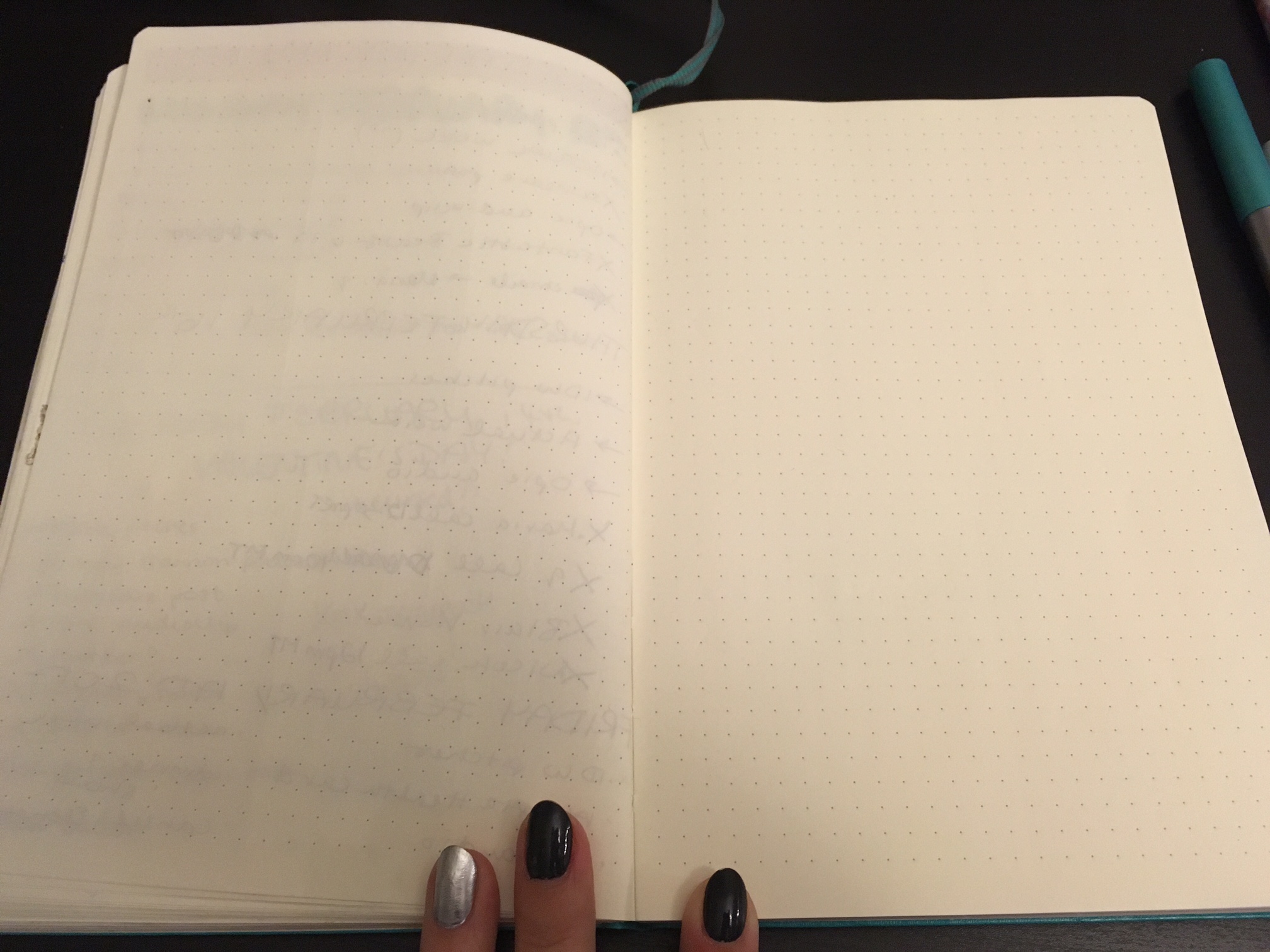
Dotted pages, not lined.
.
My tools are pretty simple. I have a selection of colorful and metallic markers and pens that I keep in this cute ALBinWonderland pouch. My friend Karyn also recently got me a set of erasable marker-pens that have really come in handy for times when I goof (frequently).

I also use this book of planner-specific stickers that I got at Staples (for cheap with my weekly 40% off coupon).
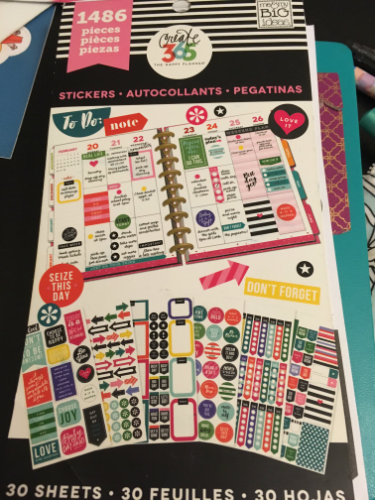
Add in some rolls of nice-lookin’ washi tape (also from Staples); a ruler; a pair of scissors (only if you really care about the edges of your tape; otherwise, just tear it); and a selection of stickers that I’ve picked up at various conventions over time.
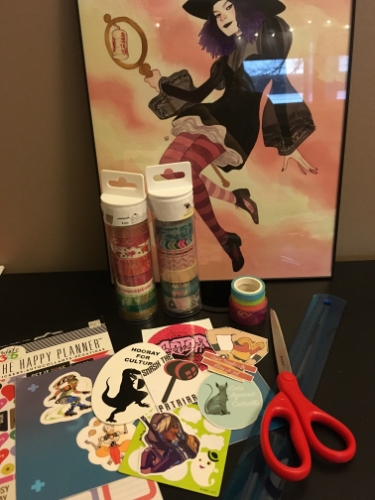
Bonus Kevin Wada commission of Nico Minoru that currently lives on my at-home work desk.
.
Now, to get into it. The great thing about the Leuchtturm1917 books is that they come with a pre-made index in the front. You use this to jot down any page numbers that you might need quick access to later. I mostly use mine to keep track of when a new month starts.
Next, the almighty bullet journaling Code. These are the different types of bullet points you use for different tasks. Most things get a regular bullet. When you finish a task, you put an X through the bullet. If something gets moved until tomorrow, you put a little -> arrow over the bullet. The rest of them I honestly don’t even really use, but people like them, so here they are.
Here’s my long-term planning page. I have a little section for each of the upcoming 6 months. Anything I plan now that will happen later in the year lives here. Traveling to the Yukon in August? Slap those dates down now so you don’t forget.
I just make these one at a time – the odds that I’ll be planning something now for October or onwards are pretty slim, so I think that’s okay. You only have to make one of these pages every six months.
At the beginning of each month, you make a “monthly spread” (read: it’s a fucking calendar). On this page, you’ll take each item in that month from that long-term planning page and move it onto its corresponding day here. Once the month begins, any plans I make for later in the month go directly on here.
Here’s how I set up my monthly boxes. That tends to be enough space for the amount that I might schedule on any given day. Down the left side, you add in each numerical date and an initial for their corresponding week day. I break it up by week with a line between every Sunday and Monday.
On the right, I’ve added a little quote, plus boxes for month-long goals and general notes. You can do anything you want with that remaining space.
Now fill ‘er in! I like to shade out-of-town travel times with pencil crayons (or “colored pencils” for you Southern heathens out there).
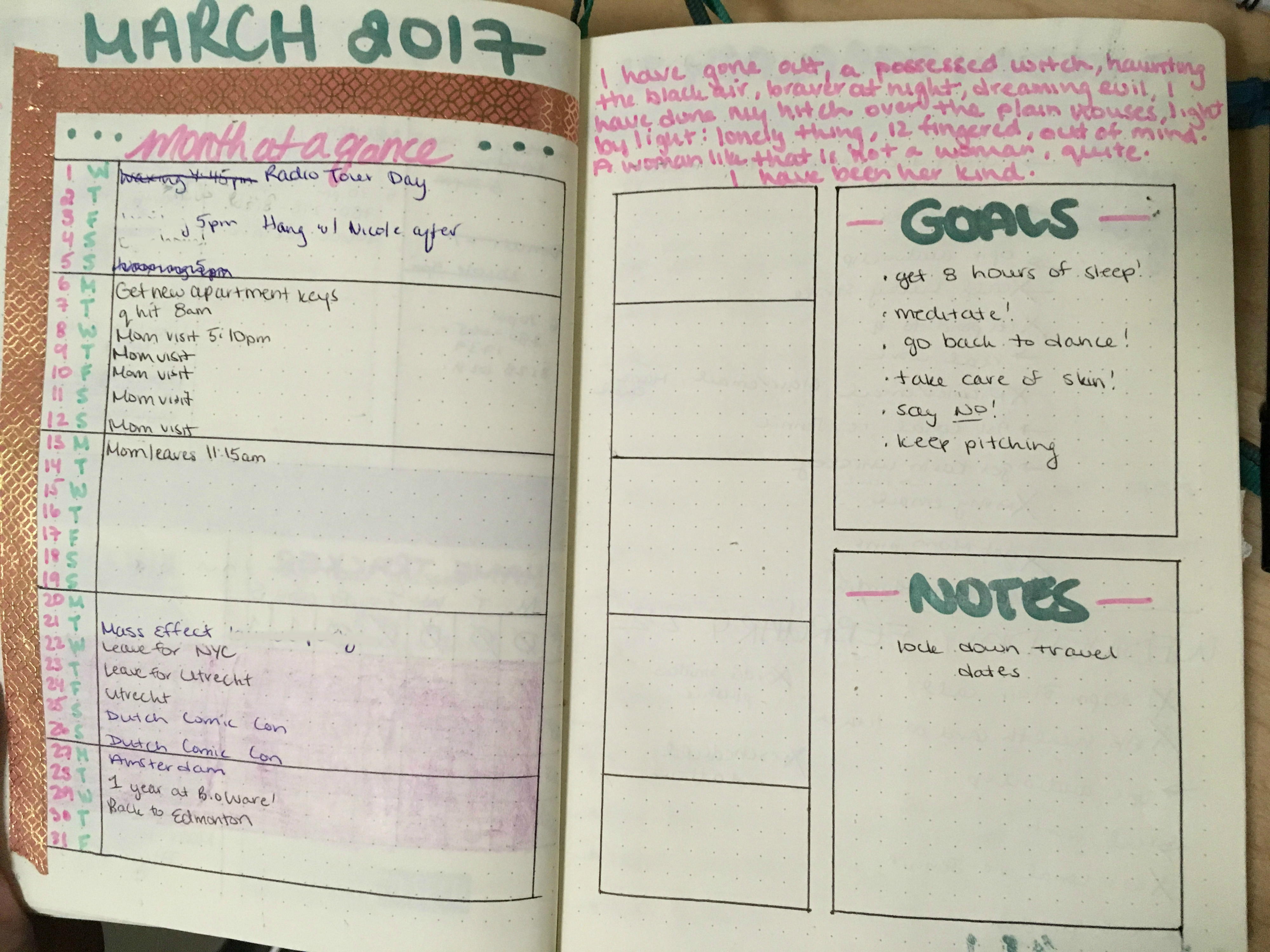
As you can see, you have to get over being precious about the look of your journal pretty quickly. I’ve had to cross a bunch of stuff out; I’ve made lines in wrong places; I’ve smudged some marker on the page. Whatever – nobody is going to see it but you, right?
That being said, this post is stressing me out. Anyways, you can take a look at February as well, which also got pretty messy.
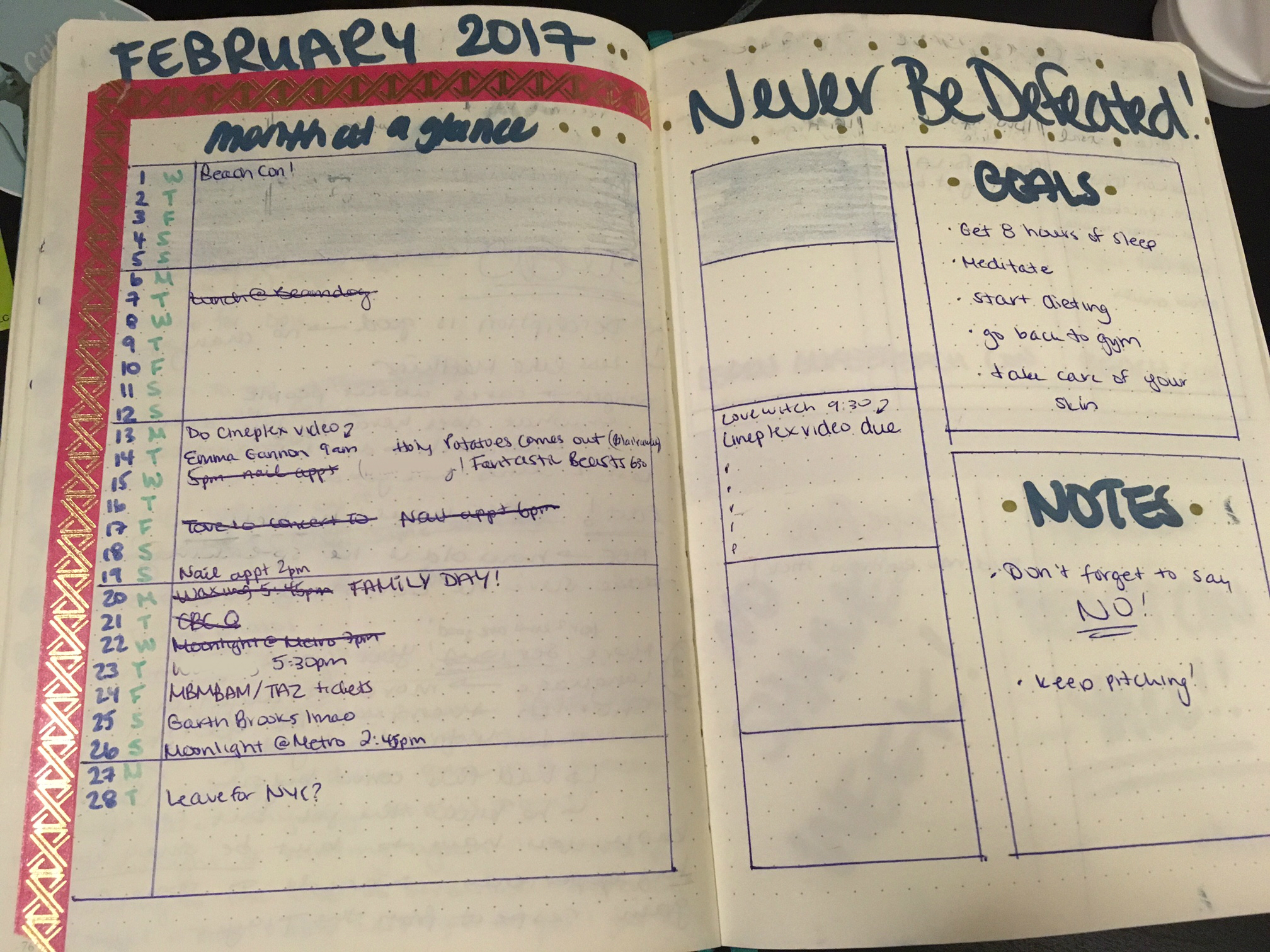
Every Sunday, I make a “weekly spread.” Everything from in my monthly spread for that coming week migrates onto here. Any plans I make for later in the week I just put here.
I split the page into 6 sections (one for each weekday and one for the weekend), and washi tape divides the page horizontally. On the bottom, I have three blocks for notes and/or stickers, and one for a daily tracker.
Add that week’s dates and whatever you’d like to track. I have cabs taken, credit card use, whether or not I read that day, whether or not I meditated that day, and how many hours of sleep I got.
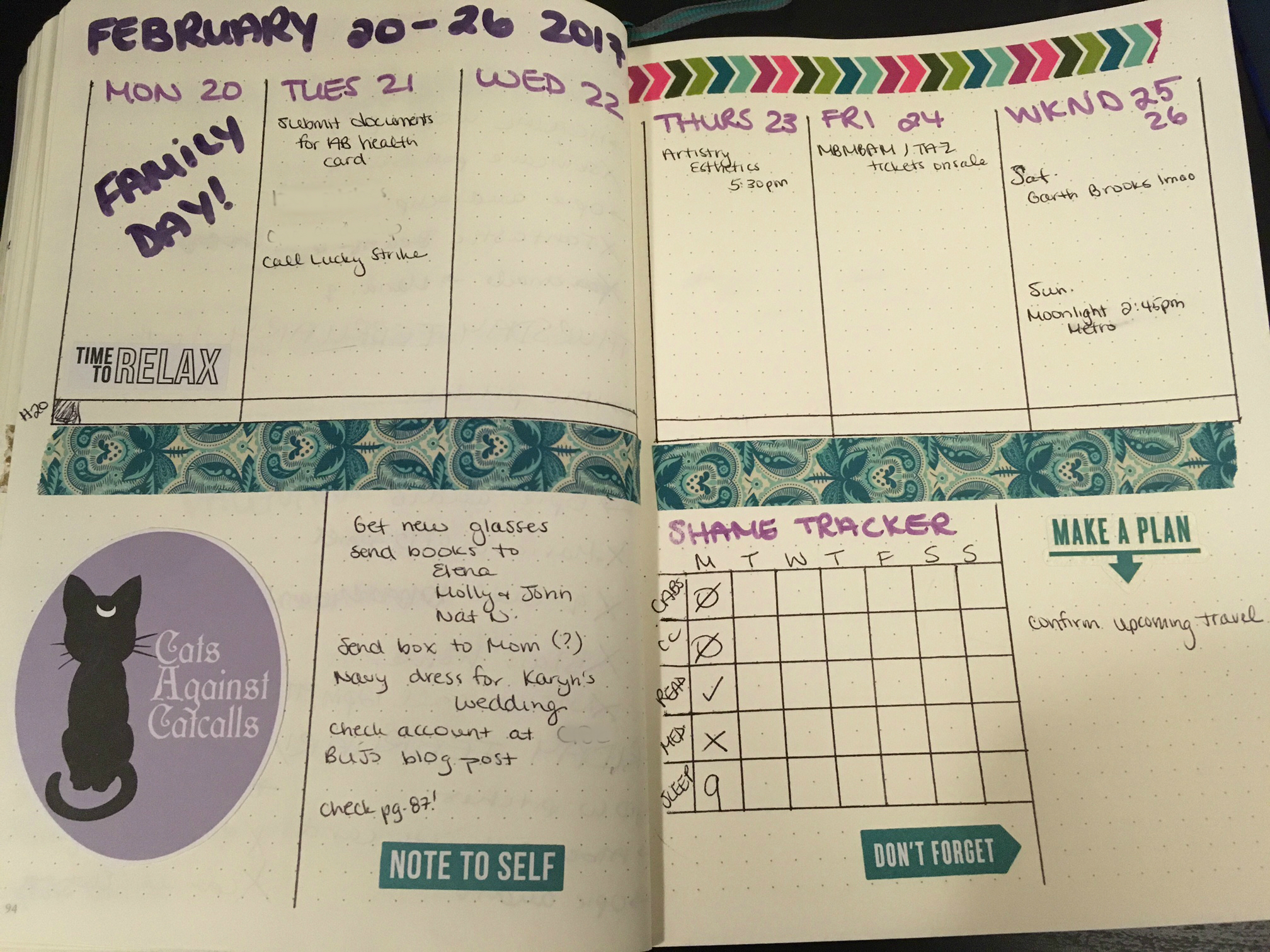
Fill that in with everything from your monthly spread. I usually use the little empty note blocks to jot down other things that I need to do during the week, but aren’t assigned to any specific date (go to the bank, mail a parcel, etc).
Then, you’ve got your daily spread! At the beginning of each day, you take whatever is in your weekly spread and put it down in bullets. This is your daily to-do list. Anything else that comes up during the day, pop it down here. Cross bullets off with X or -> them as you complete them or put them off, respectively.
Ideally every day would be pretty with tape and markers, but sometimes shit just ends up looking like this, because I make it at work on the fly. Hallowe’en got stickers; the rest of the week… did not.
What I like about the -> system in particular is that it really forces you to look at what you’ve been putting off. You have to rewrite that item each day, so it shames you into getting it done. Here you can see that I put off calling my sweet, sweet stará mama for five whole days before I finally got it done. I am a bad granddaughter.
Beyond daily planning stuff, you can also use the notebook for literally any random nonsense you want. Here’s an entry from the last day of my life, AKA the day I started playing Stardew Valley.
At the beginning of 2017, I also started a page to keep track of what games, books, movies, and TV shows I would consume during the coming year.
So that’s it! That’s the whole process. Each morning I just throw down everything I need to get done into bullet points, and any plans that come up for later in the week, month, or year go directly into their respective spreads. The only time I ever miss an appointment these days is when I leave my BuJo in my backpack for the weekend!
Keep in mind that I’m a super-beginner at this still, so if you have any questions or suggestions or want to show me your own spreads, please feel free to hit me up on Twitter @SamMaggs! This is just what works best for me, and, honestly, it’s changed my life. I’m so organized now, y’all? So organized.
Um, that doesn’t mean I want more to do, though. I’m good. We’re good here. All good.











